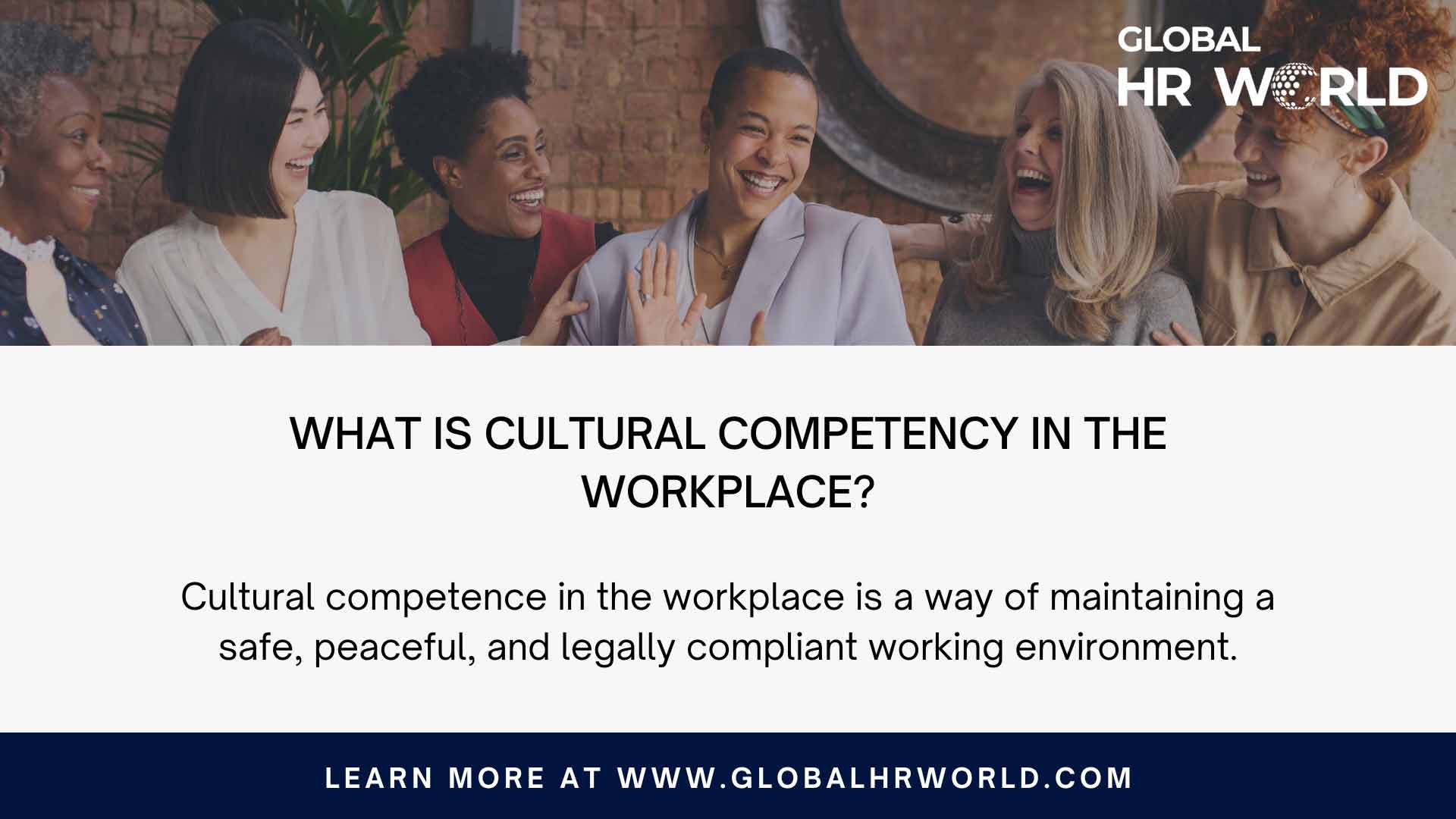Cultural competence in the workplace is very important. The PWC Annual 2021 Corporate Directors Survey found that 93% of executives believe that diversity results in unique perspectives in the boardroom, and 85% feel that it improves performance. Here we will discuss the benefits of cultural competence in the workplace. Let’s get started!
What is culture?
Culture is all around us and we are all, to some degree or another, products of the cultural socialization we grew up with through caretakers and the surrounding community. Roughly speaking, culture is a way of life that is specific to a particular people, place, or time period. Culture is a system of values, beliefs, and behaviors that social members abide by.
What is cultural competency in the workplace?
Cultural competence is, essentially, the combination of cultural knowledge, awareness, and social skills to function effectively, communicate well and generally get along with individuals of various cultural backgrounds. This is achieved by modeling and providing learning and development instruction outlining positive behaviors, attitudes, and policies.

Cultural competence in the workplace is a hugely important piece of maintaining a safe, peaceful, and legally compliant working environment. In some industries, like education and health care, the benefits of cultural competence cannot be understated as it is required for employee interaction as well as serving incredibly culturally diverse and highly vulnerable populations of learners and medical patients. Culturally competent organizations develop and implement a defined set of values, as well as practice a deliberate set of behaviors and attitudes that empower them to work effectively cross-culturally.
Examples of why we need cultural competence in the workplace
Cultural disparities can manifest themselves in different ways and the employer’s cultural competence skills and education must be deep, nuanced, and flexible enough to accurately spot, address and ameliorate the different scenarios that can arise. Here are just a few examples of the types of cross-cultural “normative” differences that, without proper sensitivity training, can manifest as misunderstandings that lead to conflicts at the workplace:
Different cultures have different conceptions of time and definitions of punctuality. For example you need to be aware that a few minutes delay to a meeting is not necessarily meant disrespectfully by the new employee because it is considered “normal” behavior in their native country.
In different cultures, there exist separate ideas of how much or how little privacy each individual deserves. For example, this includes how close people should stand when they speak with each other. Some cultures are quite forthcoming and comfortable with casual physical contact while others are made to feel awkward or offended by any uninvited physical touching.
Not all nations are “on the same page” with what constitutes appropriate vs. inappropriate topics of conversation/jokes/commentary/critique directed at coworkers in the workplace. This is why it is very important that the employer offers company-wide cultural competence education.
Sometimes, it is not the ethnic but generational differences that lead to a “culture clash” between coworkers. Within the same ethnic group, the older folks may subscribe to a very different belief system than the younger individuals among them.
To be clear: upping cultural competence at the workplace does not mean that employees have to tolerate behaviors that make them uncomfortable as a “compromise” to other cultures! Quite the opposite: it works to prevent culturally offensive acts from taking place and ensures that no one feels obligated to tolerate the ones that do slip through the cracks.
The key components of achieving cultural competence in the workplace
High-level cultural competence is a process that evolves over time. It can not be an instant, one-size-fits-all application. Here are the key components of a culturally competent workforce:

Let’s discuss.
1 – Awareness of self and others
A culturally competent workforce is aware of their own cultural worldview as well as the fact that other cultural worldviews exist and feel just as valid, real, and important to those who hold them. This awareness comes with the capability for self-reflection. An individual with true cultural competence is able to step outside one’s cultural self and acknowledge their own existing biases and capacity for prejudice. This ability to become aware outside of one’s own narrow view to get the “big picture” helps the culturally competent individual to be less defensive. This helps possibly diffuse a cultural “conflict” situation at the workplace before it sparks into something serious.
2 – Cross-cultural knowledge
Once an individual makes the philosophical leap to understanding that all cultures are subjective, it is important for a person with cultural competence to become at least somewhat familiar with other cultural practices and ways of thinking. Understanding others’ norms, beliefs and values prevent people from misinterpreting others’ behaviors and intentions on the basis of wrong cultural assumptions.
3 – Cross-cultural skills
All of the above sensibilities come together to form practical communication/interaction skills that help one be culturally considerate and sensitive and, hence, more professional, in workplace interactions. These skills include:
- Being an active listener
- Knowing how to adapt one’s interaction style to others’ cultural styles
- Fostering mutual trust among coworkers
- Being able to identify areas of cultural tension and not underestimate their influence on the workplace morale
- Directly and clearly communicating requests and instructions to others
- Instating measures that promote cultural competence and inclusion at the workplace.
The benefits of cultural competence in the workplace
Achieving cultural competence in the workplace is not a mere liability prevention measure. It is actually beneficial to organizations. Just to name a few, here are several benefits of cultural competence in the workplace:

Let’s discuss.
1 – Increased teamwork
Culturally competent employees are usually more willing to see others’ points of view, which improves teamwork in the workplace. Heightened cultural awareness at the workplace also improves overall communication among coworkers since cultural competence education encourages empathy and active listening skills. This helps in bringing together thinkers from different cultural backgrounds with the fear of “potential” conflict. Cultural competence in the work environment can help managers and employees communicate effectively and coordinate better with colleagues and customers. It can also enhance engagement with other team members and customers, along with increasing overall team performance. It can enhance problem-solving and boost creativity due to a diversity of perspectives, ideas, and strategies coming together.
2 – An adaptable and harmonious workforce
Culturally competent employees are more productive and cooperative with each other. Because of the above-mentioned open-mindedness, they are generally more adaptable to workplace changes and adjustments, which is a preferred quality in a worker. It could also help eliminate microaggressions in the workplace.
3 – A broader range of perspectives and skills
Adding a broader range of skills, knowledge, and perspectives into the work environment can enhance problem-solving skills while driving creativity. For instance, in a conference meeting with employees from different backgrounds and cultures, people may propose unexpected and new ideas, pushing the company forward.
4 – Improved employee satisfaction
When people feel heard, seen, and understood, they’re likely to feel satisfied in their roles in the workplace. Focusing on cultural competence can also help employees strengthen their self-awareness as individuals in diverse teams. Harvard Business Review reports that improved self-awareness results in greater confidence, communication, and innovation among both individuals and the teams they were a part of. This can help both employees and managers make better decisions and build lasting relationships.
5 – Greater ability to venture into new markets
With a better understanding of different cultures, businesses are in a place to venture into global markets. Culturally competent organizations know how to communicate effectively, and can better plan their marketing initiatives by learning from people of different geographies and backgrounds, be they consumers, partners, or colleagues.
Conclusion
When it comes to building cultural competence in the workplace, it is not enough to go through the motions and only make the minimum required efforts to comply with the law. The focus should be on enhancing employee satisfaction and making a consistent commitment to offering their employees the best cultural inclusion through competence training and workshops.
Infographic

Knowledge Check!
Frequently Asked Questions (FAQs)
What is culture?
Culture is a system of values, beliefs, and behaviors that social members abide by.
What is cultural competency in the workplace?
Cultural competence is, essentially, the combination of cultural knowledge, awareness, and social skills to function effectively, communicate well and generally get along with individuals of various cultural backgrounds. Cultural competence in the workplace is a hugely important piece of maintaining a safe, peaceful, and legally compliant working environment.
Why do you need cultural competency in the workplace?
Culturally competent employees are usually more willing to see others’ points of view, which improves teamwork in the workplace. Heightened cultural awareness at the workplace also improves overall communication among coworkers since cultural competence education encourages empathy and active listening skills.



